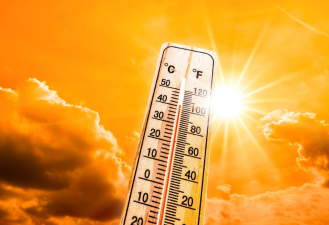The first heat wave of this summer's Northern Hemisphere has arrived, and many countries are continuing to experience scorching temperatures. Due to the "heat dome," countries like France, Italy, and Greece have issued high temperature or wildfire alerts. El Granado in southern Spain even experienced a localized extreme high of 46°C.
A heat dome is an atmospheric phenomenon in which, under still, dry summer conditions, a high-pressure zone in the upper atmosphere stagnates for a period of time, trapping the hot air like a veil and causing temperatures within the dome to rise steadily.
The Unusual Dance of Atmospheric Circulation
The unusual northward movement of the subtropical high pressure system in the western Pacific served as the igniter for this wave of high temperatures. This year, the subtropical high pressure system in the western Pacific moved northward about 20 days earlier than usual and exhibited significantly stronger intensity.
The prevailing downward airflow in its controlled area, which compresses and warms the air, coupled with clear-sky radiation, has caused surface temperatures to soar.
When the temperature reaches 32°C and the humidity is 100%, the perceived temperature can exceed 50°C.
At the same time, the combined impact of El Niño and La Niña has exacerbated atmospheric disturbances. Although the El Niño that formed in 2023 has ended, the resulting sea temperature anomalies in the equatorial central and eastern Pacific continue to influence circulation.
The region is currently rapidly shifting to a La Niña state. This dramatic fluctuation is hindering the transport of moisture from the north, exacerbating the hot, sunny, and rainless weather.
A long-term driver of global warming
The World Meteorological Organization's latest report warns: 2025 could be the warmest year on record.
Data show that the global average temperature from January to March this year was 1.52°C higher than pre-industrial levels, and the atmospheric carbon dioxide concentration reached 425 ppm, a 50% increase compared to pre-industrial levels.
The "heat shield" created by the greenhouse effect is altering Earth's energy balance:
- Low-altitude clouds over the ocean have decreased by 15%, weakening their ability to reflect solar radiation and triggering a vicious cycle of warming, cloud reduction, and further warming.
- The albedo of the Qinghai-Tibet Plateau has decreased, with spring snow cover decreasing by 12%, allowing the surface to absorb more solar radiation.
- The Arctic is warming at a rate 3.5 times the global average, and the continued retreat of sea ice is further disrupting atmospheric circulation.
This warming trend is not linear, but rather accelerating. Scientists predict that global temperatures could rise by another 0.5-1°C every decade, and extreme high temperatures will become the norm.
The amplifying effect of urban heat islands
In addition to natural factors, urbanization has become a "local amplifier" of high temperatures. Taking Zhengzhou as an example, the intensity of the urban heat island reaches 5-7°C. Under temperatures of 40°C, the perceived temperature in urban areas can reach over 45°C.
This is due to:
- Concrete buildings and asphalt pavement have a heat capacity 3-5 times that of the natural surface, absorbing heat quickly and dissipating it slowly.
- The reduction of water systems in urban green spaces has led to a lack of vegetation evaporation cooling mechanisms.
- Increased anthropogenic heat emissions, with air conditioning and traffic exacerbating localized warming.
What can ordinary people do? A "survival guide" for heat waves.
- Measures to take: When the temperature exceeds 38°C, minimize outdoor activities, especially avoid going out between noon and 3:00 PM. The elderly, children, and those with chronic diseases should be especially careful. If dizziness or vomiting occurs, immediately move to a cool place and rehydrate.
- Scientific cooling: The recommended air conditioning temperature is 26°C (both energy-efficient and comfortable). Open windows regularly for ventilation when the air conditioner is on for extended periods. Drink plenty of warm water (and avoid sugary drinks and alcohol, which can accelerate dehydration).
- -Pay attention to the "vulnerable groups" around you: check if there are elderly people living alone among your neighbors and remind them to keep cool; provide clean water and shade for stray animals.





